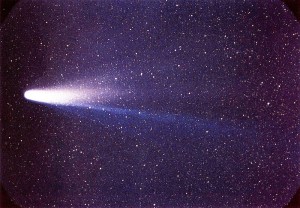Grade Level
6 - 8
minutes
1- 2 hrs
subject
Earth Science
Activity Type:
scientific illustrations, astronomy

Materials
Internet-access
blank paper
colored pencils
eraser
Humans have been observing comets for thousands of years. Though comets appear infrequently, when they do appear, they can be visible to the naked eye at night as a bright white star with a long, misty white tail trailing behind it.
On November 12th, 2014, the Philae lander successfully landed on comet 67P after a 10-year, 3-billion-mile voyage aboard spacecraft Rosetta. The event marks the first-ever landing of a space vehicle on a comet. Both Rosetta and Philae are loaded with scientific equipment for measuring the composition, gravity, appearance, and surface of the comet, opening a new chapter in our scientific understanding of comets and our early universe.
But what is a comet, anyway?
What do we know about their surface, appearance, size, tail, color, brightness, age, movement … and even their smell? In each of the interviews below, scientists (some of whom were part of the Rosetta mission) describe various comet characteristics. As you listen to these interviews, take notes as the scientists describe what a comet is like. You can use this comet characteristics graphic organizer to help you write down these descriptions.
You will then incorporate your comet descriptions, literally, into your own text illustration of a comet. A text illustration uses actual descriptive text to form the shapes and objects in a drawing. This is a great way to quickly visualize all the information you’ve learned about comets.
How To Create a Text Illustration
Listen, Watch, Read About Comets
comet characteristics graphic organizer
SciFri Excerpt: Science Diction: Comet Dec 17th, 2010
SciFri Excerpt: A Journey to the Oort Cloud, Where Comets are Born Jan 4th, 2013
SciFri Excerpt: ISON: The Comet of the Century… or Is It? Nov 22nd, 2013
SciFri Excerpt: Close-Up With a Comet Aug 15th, 2014
SciFri Excerpt: The First Touchdown on a Comet Nov 14th, 2014
SciFri Excerpt: Scientists Sniff Smelly Comet Oct 31st, 2014
SciFri Video: Comet’s Tail Shines Light on Sun Jun 7th, 2013
- Related Article: Philae settles in dust-covered ice
ESA Blog Nov 18th, 2014 - Related Article: Never Mind Philae’s Topsy-Turvy Touchdown, It’s Brief Mission Advances Comet Science
Scientific American, Nov 19th, 2014
Common Core State Standards:
CCSS.ELA-LITERACY.W.6.8, CCSS.ELA-LITERACY.W.6.2.D, CCSS.ELA-LITERACY.RI.6.7
Next Generation Science Standards:
Disciplinary Core Idea ESS1.B Earth and the Solar System
Educator's Toolbox
Meet the Writer
About Ariel Zych
@arieloquentAriel Zych is Science Friday’s director of audience. She is a former teacher and scientist who spends her free time making food, watching arthropods, and being outside.

